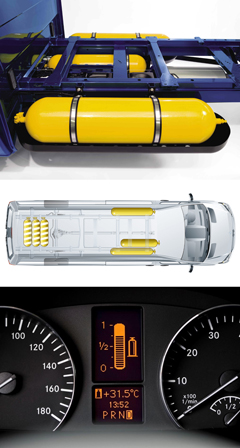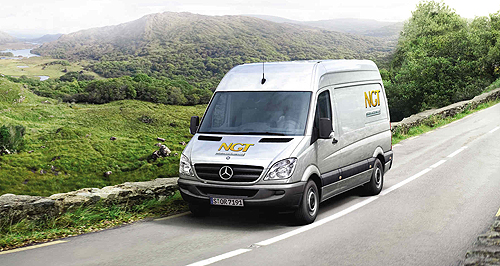Future models - Mercedes-Benz - Sprinter - NGTMercedes Sprinter goes gasDual fuel: The Sprinter NGT can run on petrol or CNG. Mercedes Australia tests market with Sprinter running on compressed natural gas19 Feb 2010 MERCEDES-BENZ is wooing fleet customers with a Sprinter van that runs on compressed natural gas (CNG) in an attempt to kick-start interest in the clean fuel. A demonstration Sprinter NGT (for natural gas technology) has been imported for potential fleet customers who have expressed an interest in the special vans, but Mercedes-Benz is committed to putting the vans on sale. The NGT Sprinter – which can also run on petrol – will be available for a premium of $7000 over the standard model. Fuelled at a price of 80 cents per kilogram and with a consumption of 10kg per 100km, it would take an average operator around 150,000km to pay off that investment. In Australia, some buses and long haul trucks have been converted to run on CNG, but the fuel is mainly only available at company depots. While there are plans to roll-out more CNG outlets, only three publicly accessible CNG filling stations have been establish in Australia. With an estimated 144 trillion cubic feet of easily accessible natural sitting under Australian soil and European CNG vehicles readily available for import, natural gas could provide Australia with a way to reduce its emissions and slash its reliance on imported oil. The company brought one CNG test van into Australia nine years ago, but decided against introducing the van locally after the business case fell over. Now, with improved technology that means the van can run on either CNG or petrol and no fuel-tank intrusion into the cargo area, Mercedes said it was the right time to introduce the vehicle.  Mercedes Vans Australia general manager Campbell York admitted the move was risky, but said his company was happy to test the Australian market. Mercedes Vans Australia general manager Campbell York admitted the move was risky, but said his company was happy to test the Australian market.“You can adopt the policy of being a leader or a follower and we choose to be a leader,” he said. Mr York said he believed there was sufficient interest in CNG that introducing models such as the new NGT Sprinter, and that doing so would help speed up the roll out of public CNG filling stations. “This is a chicken and egg scenario,” he said. “We have had significant enquiries from people interested in us bringing in alternative fuelled vehicles.” GoAuto understands large fleet customers include Australia Post, TNT and Toll are keen to evaluate the NGT Sprinter. Some delivery fleets have already laid out significant sums to purchase hybrid small trucks from Hino and Mitsubishi Fuso in a bid to reduce their CO2 emissions. Mercedes said CNG was a clean burning gas and pointed to data provided by European gas distributor Erdgas stating CNG produced 20 per cent less CO2 than petrol, 75 per cent less carbon monoxide and 59 per cent hydrocarbons. Erdgas also claimed CNG offered similar emission reductions compared to diesel, including a 99 per cent reduction in particulates. CNG should not be confused with Liquid Petroleum Gas (LPG). Mr York said Australia would benefit from increased use of CNG, as opposed to LPG, because there is so much CNG available. “CNG is a natural gas, LPG is a bi-product of petroleum and once we start to run out of oil we will run out of LPG as well,” he said. Mercedes said it was confident more public CNG filling stations would be available in Australia in the short term, with OES CNG planning to open five public filling stations in Melbourne by the end of this year. Mackleay Connelly is a manager of gas networks for Actew AGL, an ACT government and AGL joint venture energy provider, and he admits the rollout of publicly accessible CNG filling stations will be a challenge. However, he said many of the companies that would be interested in using the NGT Sprinter already have CNG at their depots to fuel forklifts or trucks. He added that the existing CNG network, delivering gas to homes in many Australian cities, could be tapped, with home filling stations like those already available in the US which can slow-fill a car overnight. Refilling with CNG at home would be more efficient that using shipped and trucked petrol and diesel, Mr Connelly said. “If you look at the way that the oil companies distribute their fuel, it’s road transport. Look at the way the natural gas industry distributes its fuel, (it is by) pipelines – very low cost, very safe, very efficient and it exists today,” he said. The new Sprinter NGT, which is part of a model revision which introduces new diesel engines and transmissions, is available in seven variants including medium and long wheelbase vans and cab-chassis models. It features a supercharged four-cylinder engine which is almost identical to the unit used in the Mercedes C200 Kompressor car, but has been revised to run on either CNG or premium unleaded petrol. The special engine can produce 115kW and 240Nm on either petrol or CNG and is available only with a five-speed automatic transmission. Three CNG tanks are located below the cargo floor. An additional three under the floor at the rear of the vehicle are available as an option. The tanks range in size between 18kg and 39kg depending on the model chosen and filling them all means the load carrying capacity of the vehicle is reduced by between 130kg and 280kg. The NGT Sprinter will be available for a premium of $7000 over the standard model. Mercedes said that with a CNG price of 80 cents per kilogram and consumption of 10kg per 100km, it would take an average operator around 150,000km to pay off that investment.  All future models Alfa Romeo Alfa Romeo Abarth Abarth Audi Audi Aston Martin Aston Martin BMW BMW Bentley Bentley Chrysler Chrysler Chevrolet Chevrolet Dodge Dodge Citroen Citroen Ferrari Ferrari DS DS Ford Ford Fiat Fiat FPV FPV Foton Foton Haval Haval Great Wall Great Wall Honda Honda Holden Holden Hyundai Hyundai HSV HSV Isuzu Isuzu Infiniti Infiniti Jeep Jeep Jaguar Jaguar Lamborghini Lamborghini Kia Kia Lexus Lexus Land Rover Land Rover Mazda Mazda Maserati Maserati Mercedes-Benz Mercedes-Benz McLaren McLaren Mini Mini Nissan Nissan Mitsubishi Mitsubishi Peugeot Peugeot Opel Opel Proton Proton Porsche Porsche Renault Renault Ram Ram Saab Saab Rolls-Royce Rolls-Royce Smart Smart Skoda Skoda Subaru Subaru SsangYong SsangYong Tesla Tesla Suzuki Suzuki Toyota Toyota Volvo VolvoSprinter pricing
Motor industry news |
Click to shareMercedes-Benz modelsResearch Mercedes-Benz All future models Alfa Romeo Alfa Romeo Abarth Abarth Audi Audi Aston Martin Aston Martin BMW BMW Bentley Bentley Chrysler Chrysler Chevrolet Chevrolet Dodge Dodge Citroen Citroen Ferrari Ferrari DS DS Ford Ford Fiat Fiat FPV FPV Foton Foton Haval Haval Great Wall Great Wall Honda Honda Holden Holden Hyundai Hyundai HSV HSV Isuzu Isuzu Infiniti Infiniti Jeep Jeep Jaguar Jaguar Lamborghini Lamborghini Kia Kia Lexus Lexus Land Rover Land Rover Mazda Mazda Maserati Maserati Mercedes-Benz Mercedes-Benz McLaren McLaren Mini Mini Nissan Nissan Mitsubishi Mitsubishi Peugeot Peugeot Opel Opel Proton Proton Porsche Porsche Renault Renault Ram Ram Saab Saab Rolls-Royce Rolls-Royce Smart Smart Skoda Skoda Subaru Subaru SsangYong SsangYong Tesla Tesla Suzuki Suzuki Toyota Toyota Volvo VolvoSprinter pricing
Motor industry news |














Facebook Twitter Instagram